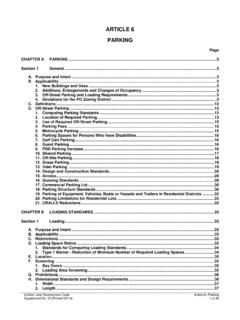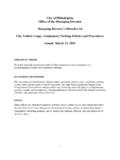Transcription of Chapter XVII OFF-ROAD RECREATION VEHICLE CODE
1 Chapter xvii OFF-ROAD RECREATION VEHICLE code 1701. TITLE. This code shall be known and cited as the Bay Mills Indian Community OFF-ROAD RECREATION VEHICLE code or also known as the ORV code . 1702. DEFINITIONS. The following terms shall have the meanings described below for the purpose of this code : A. ATV : A 3- or 4-wheeled VEHICLE designed for OFF-ROAD use that has low-pressure tires, has a seat designed to be straddled by the rider, and is powered by a 50cc to 500cc gasoline engine or an engine of comparable size using other fuels. B. Dealer : Any person engaged in the sale, lease, or rental of ORVS as a regular business. C. Highway or street : The entire width between the boundary lines of every way publicly maintained if any part thereof is open to the use of the public for purposes of vehicular travel. D. Operate : To ride in or on and be in actual physical control of the operation of an ORV. E. Operator : Any person who operates or is in actual physical control of an ORV.
2 F. ORV : A motor driven OFF-ROAD RECREATION VEHICLE capable of cross-country travel without benefit of a road or trail, on or immediately over land, snow, ice, marsh, swampland, or other natural terrain. ORV or VEHICLE includes, but is not limited to, a multitrack or multiwheel drive VEHICLE , an ATV, a motorcycle or related 2-wheel, 3-wheel, or 4-wheel VEHICLE , an amphibious machine, a ground effect air cushion VEHICLE , or other means of transportation deriving motive power from a source other than muscle or wind. ORV or VEHICLE does not include a registered snowmobile, a farm VEHICLE being used for farming, a VEHICLE used for military, fire, emergency, or law enforcement purposes, a ORV code 17-1 VEHICLE owned and operated by a utility company or an oil or gas company when performing maintenance on its facilities or on property over which it has an easement, a construction or logging VEHICLE used in performance of its common function, or a registered aircraft.
3 G. Owner : Any of the following: 1. A person who holds the legal title to an ORV. 2. A vendee or lessee of an ORV that is the subject of an agreement for conditional sale or lease with the right of purchase upon performance of the conditions stated in the agreement and with an immediate right of possession vested in the conditional vendee or lessee. 3. A person renting an ORV or having the exclusive use of an ORV for more than 30 days. H. Right-of-way : That portion of a highway or street less the roadway. I. Roadway : That portion of a highway or street improved, designated, or ordinarily used for vehicular travel. If a highway or street includes 2 or more separate roadways, the term roadway refers to any such roadway separately, but not to all such roadways collectively. J. Shoulder : That portion of a highway or street on either side of the roadway that is normally snowplowed for the safety and convenience of vehicular traffic.
4 K. Tribal Police Officer or Tribal Officer : Law enforcement officer who is employed by the Bay Mills Indian Community, including conservation officers. L. Tribe : 1. The Tribe : The Bay Mills Indian Community. 2. A Tribe : Any federally recognized Tribe. 1703. CIVIL INFRACTION. Any offense within this ORV code that does not include imprisonment as a possible penalty is deemed to be a civil infraction. As such, the standard of proof is by a preponderance of the evidence at any hearing or trial on a civil infraction offense. ORV code 17-2 1704. BAY MILLS TRIBAL COURT; JUDGE; MAGISTRATE. The Judge of the Bay Mills Tribal Court shall preside over any hearing or trial involving an alleged violation of this code . However, the Bay Mills Tribal Court Magistrate shall have the authority to conduct arraignments on any and all offenses within this code ; in addition, the Magistrate may impose sentencing where a person pleads guilty to an offense under this code that imposes a fine of less than or equal to one hundred ($100) dollars.
5 1705. PENALTIES NOT OTHERWISE PRESCRIBED. Any person who is convicted of or found responsible for an offense enumerated in this code for which the penalty is not otherwise prescribed may be sentenced to a payment of a fine not to exceed one hundred ($100) dollars. 1706. REGULATION OF OFF-ROAD RECREATION VEHICLE OPERATIONS; PROHIBITIONS GENERALLY. A person shall not operate an ORV upon a public highway, street, roadway, or private parking lot within the Bay Mills Indian Community not specifically designated for the use of ORVs except under the following conditions and circumstances: A. An ORV may be operated on the right-of-way of a public highway, roadway, or street if it is operated at the extreme right of the open portion of the right-of-way and with the flow of traffic on the highway. ORVs operated on the right-of-way of a public highway, roadway, or street, as herein provided, shall travel single file and shall not be operated abreast except when overtaking and passing another ORV.
6 B. An ORV may be operated across a public highway, roadway, or street, at right angles to the highway, roadway, or street, for the purpose of getting from one area to another when the operation can be done in safety. An operator shall bring his ORV to a complete stop before proceeding across the public highway, roadway, or street, and shall yield the right-of-way to all oncoming traffic. C. A tribal police officer may authorize use of an ORV on a public highway, roadway, or street when an emergency occurs and conventional motor vehicles cannot be used for transportation due to snow or other extreme highway conditions. D. Penalty. A person violating this Section may be sentenced to a fine not less than fifty ($50) dollars but not more than five hundred ($500) dollars. ORV code 17-3 1707. OPERATION OF OFF-ROAD RECREATION VEHICLES; PROHIBITED AREAS. A. Property of others. A person shall not operate an ORV upon land that is leased, owned, or under the control of someone else, unless they have obtained written consent or permission from the appropriate person(s).
7 B. Golf Course. A person shall not operate an ORV on the golf course located within the Bay Mills Indian Community, with the exception of the operation of motorized and authorized golf carts on paved cart paths. C. Posted Areas. A person shall not operate an ORV in any area that has been posted as being closed to OFF-ROAD RECREATION vehicles or posted as no trespassing . D. Frozen Surface of Public Waters. A person shall not operate an ORV on the frozen surface of public waters within one hundred (100) feet of a person, or within one hundred (100) feet of a fishing shanty or shelter except at the minimum speed required to maintain forward movement of the ORV, or on an area which has been cleared of snow for skating purposes. E. Forestry. A person shall not operate an ORV in a forest nursery, planting area, or public lands posted or reasonably identifiable as an area of forest reproduction when growing stock may be damaged. F.
8 Tribally Designated Preserves. A person shall not operate an ORV on a tribally designated preserve, except on roads, trails, or areas specifically designated for ORVS. A tribally designated preserve includes but is not limited to land posted or utilized as a wetland preserve, wildlife preserve, or agricultural preserve. G. Cemeteries. A person shall not operate an ORV on or across a cemetery or burial ground. H. Penalty. A person violating this Section may be sentenced to a fine not less than fifty ($50) dollars but not more than five hundred ($500) dollars. In addition, the person may be liable for restitution as to damages he or she caused to any property. ORV code 17-4 1708. OPERATION BY MINORS/INCOMPETENTS. A. A parent or legal guardian shall not permit his or her child who is less than 14 years of age to operate an ORV except when there is direct visual supervision of an adult and the ORV is being operated on land leased or under the control of a parent or legal guardian or on the land of others where written consent or permission was obtained.
9 B. A person who is at least 14 but less than 16 years of age may operate an ORV if the following conditions exist: 1. The person has in his or her immediate possession an ORV safety certificate issued by the Tribe, the State of Michigan, or that was issued to the person under the authority of a law of another tribe, state or province of Canada; and 2. The person is under the direct visual supervision of an adult. C. A person who is operating an ORV pursuant to subsection (B) (1) shall present the ORV safety certificate to any tribal officer upon request. D. A person who is less than 14 years of age shall not cross a highway, roadway, or street. An operator who is at least 14 years of age but less than 16 years of age may operate an ORV on the right-of-way on a public highway, roadway, or street pursuant to Section 1706 (A) or may cross a highway, roadway, or street pursuant to Section 1706 (B) only if he or she has a valid ORV safety certificate in his or her immediate possession and is under the direct visual supervision of an adult.
10 E. A person who is at least 16 years of age but less than 18 years of age may operate an ORV on the right-of-way on a public highway, roadway, or street pursuant to Section 1706 (A) or may cross a highway, roadway, or street pursuant to Section 1706 (B) only if he or she has a valid ORV safety certificate in his or her immediate possession. F. A person who is less than 16 years of age shall not operate an ORV with a passenger except on land leased or under the control of a ORV code 17-5 parent or legal guardian or on the land of others where written consent or permission was obtained. G. The owner or person in charge of an ORV shall not permit the ORV to be operated contrary to this Section. H. A parent or guardian of a minor shall not permit a minor to operate an ORV contrary to this Section. I. The owner or person in charge of an ORV shall not knowingly permit the VEHICLE to be operated by a person who is incompetent to operate the VEHICLE because of a mental or physical disability.




